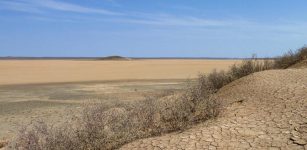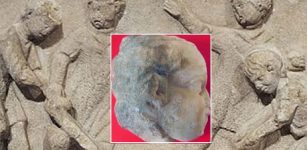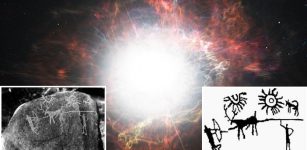How Did Climate Change Impact European Ice Age Humans?
Jan Bartek - AncientPages.com - A comprehensive study examining fossil human teeth from Ice Age Europe has revealed significant insights into how climate change affected prehistoric human populations. This research, utilizing the largest dataset of human fossils from Ice Age Europe to date, covers the period between 47,000 and 7,000 years ago.
The study demonstrates that prehistoric hunter-gatherers experienced substantial demographic shifts in response to climate change. During the coldest periods, population sizes decreased dramatically. In Western Europe, the situation was particularly dire, with Ice Age Europeans facing the threat of extinction.
Credit: NASA - Public Domain
The research timeline begins approximately 45,000 years ago when modern humans first migrated to Europe during the last Ice Age, marking the start of the Upper Paleolithic period. These early human groups managed to maintain a continuous presence on the European continent, even persisting through the Last Glacial Maximum around 25,000 years ago. During this time, glaciers covered extensive areas of northern and central Europe, presenting significant challenges to human habitation.
"Archaeologists have long debated the influence of climatic changes and the associated new environmental conditions on the demography of hunter–gatherers at that time. Due to the limited number of fossils available and their often poor molecular preservation for ancient DNA analysis, it has been very difficult to draw conclusions about the impact of climatic factors on migration, population growth, decline, and extinction," explains Dr. Hannes Rathmann from the Senckenberg Center for Human Evolution and Palaeoenvironment at the University of Tübingen (Germany) and the study's first author.
Together with a research team from Italy, the U.S., and Germany, Rathmann therefore chose a new approach to clarify this question: Instead of analyzing the few scattered prehistoric individuals for which ancient DNA is available, the team examined their teeth.
"Teeth are the hardest tissue in the human body and are therefore the most common fossil skeletal elements found by archaeologists.
"This has allowed us to collect an unprecedented dataset significantly larger than previous skeletal and genetic datasets. Our newly compiled collection includes dental data of 450 prehistoric humans from all over Europe, covering the period between 47,000 and 7,000 years ago," explains Dr. Rathmann.
The team analyzed tooth characteristics, including crown cusps, ridge patterns, and third molar presence. Dr. Rathmann explains that these traits show genetic relationships without needing ancient DNA. Researchers also examined fossil photographs, including lost specimens. The study found significant genetic connectivity between Western and Eastern European populations from 47,000 to 28,000 years ago.
"This finding is consistent with our previous knowledge from archaeological studies, which identified widespread similarities in stone tools, hunting weapons, and portable art from the different regions," explains co-author Dr. Judith Beier from the DFG Center for Advanced Studies Words, Bones, Genes, Tools at the University of Tübingen.
The period in question saw Europe predominantly covered in open steppe landscapes, which were capable of sustaining substantial herds of mammals. These animals served as the primary food source for hunter-gatherer populations. Such environmental conditions likely facilitated connections between different groups of people.
In the following era, known as the Late Pleniglacial (28,000 to 14,700 years ago), genetic studies reveal a lack of connections between Western and Eastern European populations. Furthermore, research indicates that both regions experienced a significant decrease in population size. This demographic decline resulted in a reduction of genetic diversity within these populations.
These findings provide valuable insights into the population dynamics and genetic patterns of prehistoric Europe, highlighting how environmental factors and climatic changes influenced human migration and genetic diversity over time.
"This drastic demographic change was probably caused by massive climate changes: Temperatures during this period dropped to the lowest values of the entire Upper Paleolithic and culminated in the Last Glacial Maximum, a time when ice sheets reached their greatest extent and covered most of northern and central Europe," explains Dr. Rathmann.
Three human skulls from the Hohlenstein-Stadel cave in Southern Germany, dated to about 8,500 years ago, likely belonging to a family: a man (left), a woman (right), and a child (middle). Credit: Osteological Collection, University of Tübingen
"The deteriorating climate caused a shift in vegetation from steppe to a predominantly tundra landscape, which affected the habitats of prey animals and, consequently, the hunter-gatherers who depended on them."
Dr. Beier adds, "Our results support the long-held theory that populations were not only driven southward by advancing ice sheets but also separated into largely isolated refugia with more favorable environmental conditions." Another remarkable finding of the study is the discovery that populations in Western Europe went extinct at the transition from the Middle to the Late Pleniglacial and were replaced by a new population that migrated from Eastern Europe.
After the Late Pleniglacial, rising temperatures and retreating glaciers allowed vegetation to return, enabling the recolonization of abandoned areas. Previously isolated populations in Western and Eastern Europe grew and resumed migration.
The research team developed a machine learning algorithm called Pheno-ABC, which reconstructs prehistoric demographic events using morphological data. This new method identifies the most likely demographic scenario among many tested.
Dr. Rathmann emphasizes the study's insights into Ice Age Europeans' demographic history and the impact of climate changes on prehistoric humans. He suggests learning from the past to address future environmental challenges.
The study was published in the journal Science Advances
Written by Jan Bartek - AncientPages.com Staff Writer






















